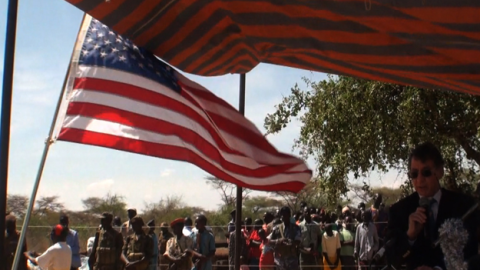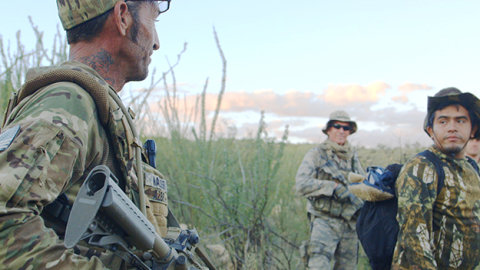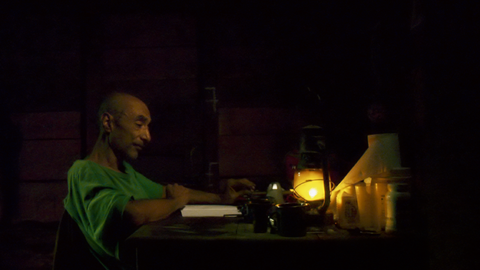Make It Real: The Filmmaker as Adventurer
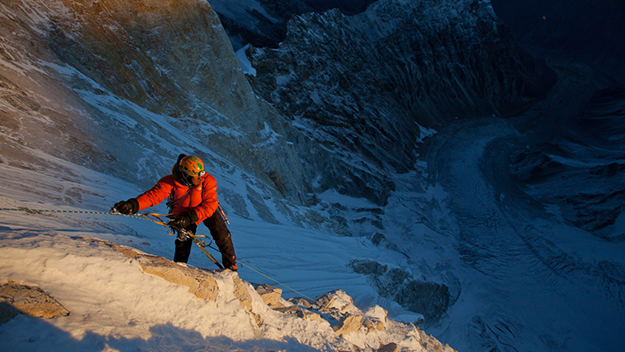
Meru
Around two-thirds of the way through Meru, co-director and professional mountain climber Jimmy Chin has a crisis of faith. It’s right after a failed initial attempt to scale the Shark’s Fin on Mount Meru in Northern India, and it follows a pair of near-death encounters with a landslide and a partner’s massive brain injury. “I took off for a while. I disappeared off the map. I needed some time to really contemplate,” he says into the camera, before we cut to images of him trudging solo up a snowy mountainside, and then staring off into the distance. It’s a beat familiar from thousands of hero stories, from Superman giving up his powers and getting into a bar fight in Superman II to Neil Diamond hitchhiking and becoming a bearded folk singer in The Jazz Singer, with infinite miles of distance-staring logged in-between. We know what comes next. We know that Chin will get back on the horse, as it were. We know that after a training sequence his injured partner Renan Ozturk will rejoin him and their square-jawed Teutonic mentor Conrad Anker to overcome the odds, affirm their manhood, and climb every mountain.
The difference is that here the director casts himself as the hero. Whether he’s in front of or behind the camera, that dual role turns the filmmaking itself into a heroic act. “How did they do that?” merges with “How did they film that?” And because Meru follows a classic heroic arc, rather than an antiheroic or deconstructed one, Chin and co-director Elizabeth Chai Vasarhelyi do nothing to challenge that conflation. The desired effect is awe all around.
The director-as-adventure-hero conceit has a very long history, stretching back to the early silent films of the American Romantic tradition, in which far-flung lands were explored and visually captured for the audience’s edification and amazement, and in which the dangers faced by the filmmakers were sometimes acknowledged but always implied. That’s often been the case for travelogues as well as for war pictures—the proximity of the camera to danger grants us vicarious excitement, and engenders gratitude for the risk it required. That’s been a key element in discussions of Cartel Land since it took home a cinematography prize (as polished films involving high-risk shoots often do) at Sundance in January. Director Matthew Heineman never appears on camera, but we’re constantly aware of the volatility of the environments he and co-cinematographer Matt Porwoll have thrust themselves into. (It’s not for nothing that Manohla Dargis led off her review in The New York Times with the following: “The director Matthew Heineman has a terrific eye. And, to judge from ‘Cartel Land,’ his immersive documentary about American and Mexican vigilante groups, he also has guts and nerves of steel.”) Again, the filmmaking itself becomes heroic, with the visual texture of that heroism—the camera jostling, the where-is-that-gunshot-coming from whip pans—registering as much if not more than the action being captured. (We’re not necessarily emotionally invested in everyone we see in a given scene, but all that reactive camera movement ensures that we identify, and feel, along with the person capturing it.)
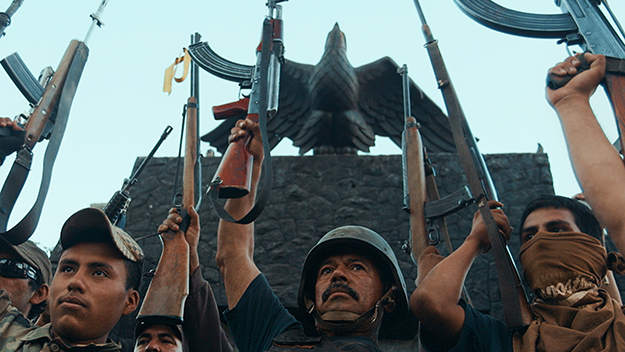
Cartel Land
To its credit, Cartel Land cops to this tension in its conceit, effectively sharing with the audience the filmmakers’ experience in infiltrating the complicated world of cartels and rebellious autodefensas in Mexico. As a story of talented filmmakers in over their heads in a foreign land, diving deep and capturing incredible sights but not necessarily understanding the nuances of the politics or culture at hand, it’s a fascinating, often thrilling document. Unfortunately the film also offers an ideas-piece thesis about vigilantism, intercutting footage of the autodefensas with American militia yahoos on the New Mexico border, a misfire that invalidates the film’s otherwise serviceable naive POV. There’s a crucial difference between the limited-but-clear stance of “there were a lot of things we didn’t understand, but check out what we witnessed” and the specious simplification of “things aren’t quite what they seem to be.” The latter asserts that what the foreign visitor witnessed and understood, actually is. When going in with foreign eyes, you’re always dealing in what appears to be. Spinning those appearances into an assertion can be a dicey proposition.
It should be said that these narratives are often very effective. The adventurer-filmmaker and the adventure of the filmmaking apparatus transport audiences into foreign environments. The more present and relatable and heroic our conduits are, the more amenable we are to be taken there. It can also make for highly entertaining cinema. Try breathing when the autodefensas engage in an urban street battle with cartel holdouts, or when the suspended pod the climbers sleep inside suddenly breaks in Meru, leaving them suspended 21,000 feet in the air. From silent-era expeditions to GoPro-captured climbing films (a popular subgenre in its own right), and from frontline reportage to first-person shooter games, the closer we can get—and the more thoroughly and convincingly we can be placed there—the better.
Hubert Sauper certainly looks and plays the part of an adventurer-filmmaker in We Come as Friends. He doesn’t just travel from France to Sudan to make the film—he gets there in his own hand-made plane. From the outset, Sauper is present on screen, behind the controls of the tiny plane as it putt-putts over the Sudanese landscape, and talking to locals and officials who wonder what he’s doing. But also from the outset, he makes plain that he’s an interloper in this land, that he, and by extension we, are “aliens” in Sudan. And it defines the entire film. Whereas the events of Cartel Land are, or at least prove to be, strange to us, transpiring in flashes before we have a chance to know who is who or whom we can trust, in We Come as Friends, we are the strangers, the object of curiosity. We’re watching people react to Sauper, to the camera, to the ludicrous little plane. Of course we’re also learning things, gaining information, and accessing environments we likely haven’t before, but not without constantly confronting the fact that we’re the interloping force, that we don’t know the half of everything we’re encountering. This transforms how we see, but it also asks us to see as if through different, specifically Sudanese eyes. Sauper isn’t just our conduit, he’s a white Westerner, the likes of which we encounter throughout Sudan, the likes of which we come—or ought to come—to distrust.
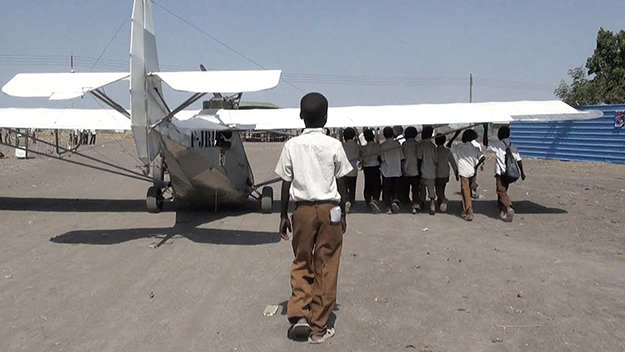
We Come as Friends
Sauper plays the cinematic explorer in order to deconstruct the whole idea of the cinematic explorer. He’s a hero who also plays the fool. He flies into dangerous lands, in a vehicle he craftily built himself, only to have his flying machine become the butt of jokes, a source of hearty, astonished laughter. You’re crazy, they say, and what they mean is, you’re ridiculous. That laughter becomes a useful journalistic catalyst—Sauper is seemingly a mastermind at earning the trust of backslapping Western exploiters—but it keeps us constantly questioning why we’re here, why we’re bothering these people. The answers aren’t pretty. As he told me last year, in discussing missionaries from Texas that he films handing out white socks to otherwise naked village children, he’s part of the invading force regardless of however he thinks of himself. “People thought we were also missionaries, but you can’t say: ‘I’m not a missionary, I’m a nice guy.’ Because I’m not—I’m the same, with the same kind of face.”
Meanwhile, Meru is so focused on the brave acts of the filmmaker and his fellow climbers that you can quite literally blink and miss the geographic contextualization for their exploits, which comes via zippy, clichéd shots of Tibetan worshippers and exoticized market exchanges. (In fairness, cursory research reveals that in real life the subjects seem more invested in these encountered cultures than the film makes time to represent.) So firmly affixed is the film to a heroic narrative that any complicating factors are dispatched as quickly and cursorily as they’re introduced. Should Ozturk go back to Meru a mere four months after suffering a potentially crippling cranial injury? Well, he’s just that determined. Should he have honored the concerns of his girlfriend in the matter, and not bought a plane ticket without telling her? Well, he’s just that determined. Boys will be boys. (And here’s best-selling author Jon Krakauer to legitimize it all.)
The fact and the drama of their pursuit needn’t be totally punctured in order to dwell on these questions, but by refusing to adequately do so the film becomes as limited, and as vacant, as the thrill-seeking sensation itself. It’s hard to believe this tack was taken in the wake of Lucy Walker’s snowboarding doc The Crash Reel, which honors the experiences of those who love and have to live with risk-takers like Ozturk without completely invalidating his impulses. Meru merely glances at these other points of view, and ultimately only to function as second-act complications that its heroes have to overcome in order to triumph (cue the power chords and Eddie Vedder incantations).
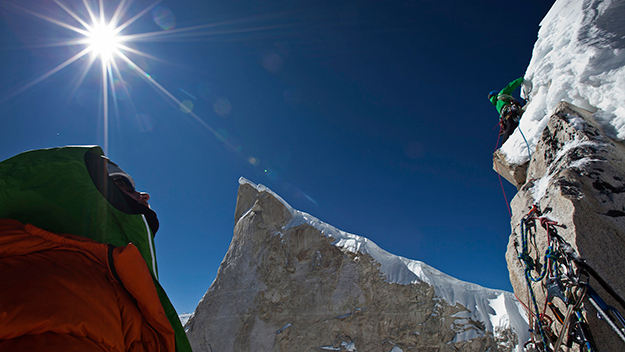
Meru
“Why do we do this stuff?” Chin asks at one point, laughing at a line he’s apparently used before. “The view.” To some degree, that’s the reason all three filmmakers have done all this stuff, and why a lot of documentarians do what they do. An adventuresome impulse leads them to see what they wouldn’t normally get a chance to see, which they then make visible to us. But unless you’re asking after the value of the view, and acknowledging the strengths and limitations of the viewer, it’s really just sight seeing. You go up, you go down, and then you get to go home.
Meru and We Come as Friends both open on August 14. Cartel Land is now playing in theaters.



